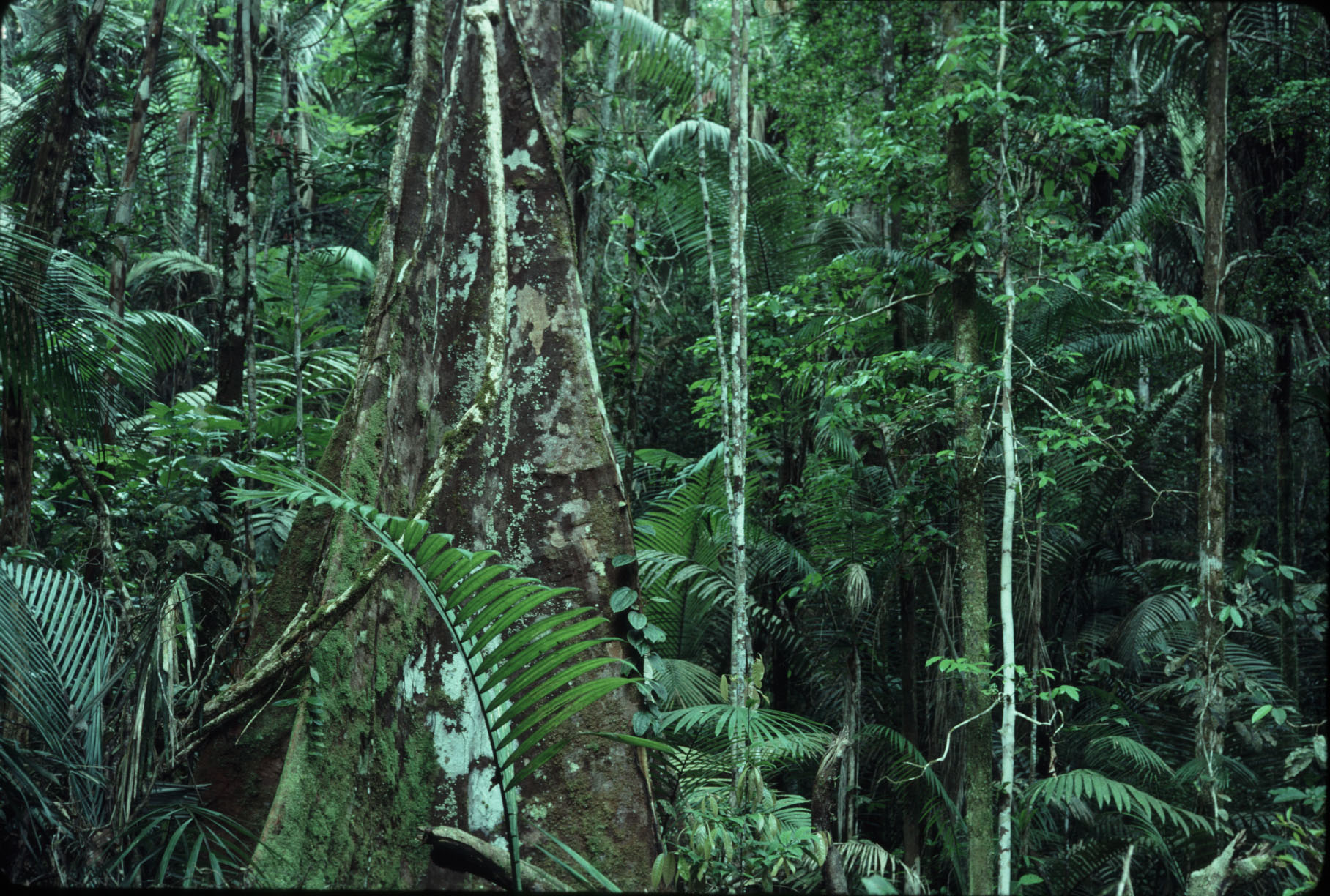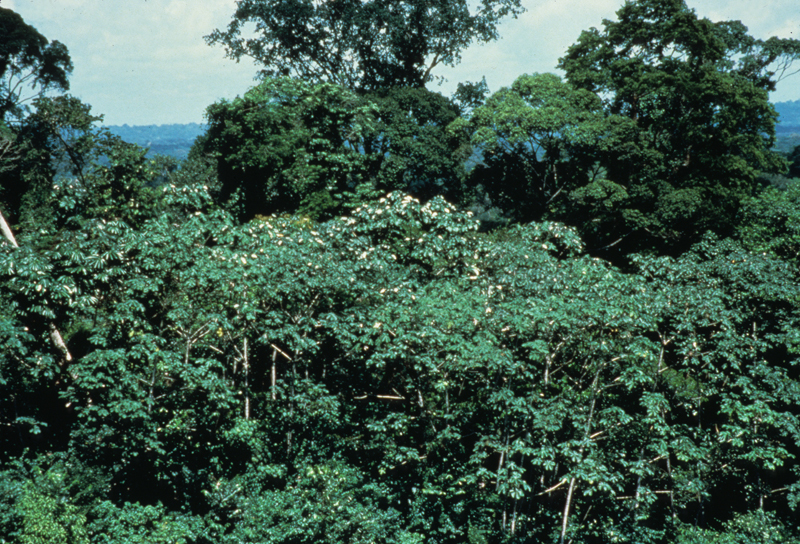Garden Scientist Weighs In on Rain Forest Debate
Posted in Science on February 26 2009, by Plant Talk
 |
Scott A. Mori, Nathaniel Lord Britton Curator of Botany, has been studying New World rain forests at The New York Botanical Garden for 40 years. |
 Primary rain forest in central Brazilian Amazon
Primary rain forest in central Brazilian AmazonThis forest has as many as 285 different species of large trees in a single hectare (about 2.5 acres) among which are as many as 24 species of the Brazil nut family. The adjacent secondary forest that developed after cutting and burning has as few as one to three different species of large trees and not a single species of the Brazil nut family. Photo by Carol Gracie
Last month I attended a symposium hosted at the Smithonsian Institution titled “Will the Tropical Rainforests Survive? New Threats and Realities in the Tropical Extinction Crisis” This well-organized and engaging symposium served as the basis for subsequent articles in The Economist and The New York Times that have sparked lively debate. After reading these articles, I was prompted to write this blog to clear up some of the misconceptions that have arisen from the symposium.
(For readers who are not familiar with the terminology used to describe forest regeneration after deforestation, I provide a brief explanation of the process after the jump; see below.)
In the first place, there is no debate about the need to preserve primary forest among biologists who have studied tropical ecosystems. On several occasions the speakers and the moderator stated that the protection of primary forest is still a high priority. Moreover, there was no disagreement that primary forest continues to be destroyed at a high rate. There was, however, disagreement about the exact rate of primary forest destruction with the most pessimistic figures being 90% and the most optimistic being 32% lost by 2050. Considering that the Food and Agriculture Organization of the United Nations estimated that just 36% of the world’s forests remained relatively untouched in 2005, I can say that all estimates of primary forest destruction given at the symposium are most likely unacceptable to every single biologist in attendance at the symposium.
Another misconception is that biologists are debating whether secondary forests can protect more than a fraction of the biodiversity found in primary forests, and no speaker in the symposium actually said that secondary forests can possibly protect the vast biodiversity found in more mature forests. What was said is that secondary forests are: 1) the first step in regenerating biodiversity after large-scale disturbance, 2) useful as corridors for plants and animals to move from one area of old-growth forest to the next, and 3) providers of ecosystem services such as protecting soil, maintaining hydrological cycles, and sequestering carbon. I believe that most biologists attending this symposium would agree that old-growth forests do all of these things better than secondary forests but that secondary forests are better than completely deforested areas for providing ecosystem services and protecting biodiversity.
One of my research specialties is the classification, ecology, and evolution of New World tropical species of the Brazil nut family (Lecythidaceae). This family of trees is one of the dominant groups of trees found in lowland rain forests, serves as a symbol of this type of vegetation, and can be considered as the plant equivalent of the panda! As part of this research, my colleagues and I established a 100-hectare plot (250 acres) in primary forest in the Brazilian Amazon in which we located and mapped nearly 8,000 trees of this family. In that plot, we found 38 different kinds (species) of the Brazil nut family and have observed that in the nearby secondary forests that had arisen after cutting and burning of primary forest almost all of these species are gone. If all primary forests were eliminated nearly all of the species of the Brazil nut family would be lost forever because there would be no seed sources left to get them reestablished. If the protection of biodiversity is a goal, then secondary forests by themselves are not the answer and this, in my opinion, is not under debate by tropical biologists.
Learn about forest regeneration after the jump…
 Secondary growth stages in French Guiana
Secondary growth stages in French GuianaThe band of trees in the foreground is secondary forest dominated by the single species Cecropia obtusa. Secondary forests such as this are important for preserving biodiversity because they create the conditions that allow for other species to invade the area. If there is ample seed source in the area and if there is no further disturbance, a secondary forest such as this may eventually lead to the regeneration of primary forest, but this may take as long as 200 years. Photo by Merlin Tuttle of Bat Conservation International
Primary forest (also called old-growth forest) is forest that has not had major disturbance for long periods by landslides, hurricanes, large blowdowns, floods, or human logging, agriculture, or ranching. After large-scale disturbance occurs, the species of trees that colonize the disturbed land are called secondary species and the long process of regenerating a forest similar in makeup to the original primary forest via different stages of secondary forest is called plant succession. There are relatively few tree species that are able to colonize disturbed areas but the ones that do create the conditions needed for other species to grow in the area. Thus, as time passes, the number of species in secondary forests increases and several hundred years later the diversity of trees may once again approximate the diversity of the original primary forest. All studies of plant succession in the tropics show that there are more species of plants in old-growth forests than there are in secondary forests and this is also true for most, but perhaps not all, groups of animals.
(Read Scott’s letter to The New York Times.)


I am tropical ecologist and systematist working in Central Africa and I would like to add to the discussion that saving old grown or primairy forest is not enough. Climate change is likely to decimate tropical rainforests in the next few decades and yet few conservation strategies examine and take into account the impact of global warming and drought on plant biodiversity and forest survival.
Climatically resilient forests are nodes in the web of life hidden within present-day rainforests; they form patches of forest cover where local conditions related to topography and elevation have in the past, and continue to compensate for regional drought stress caused by climate change. Climatically resilient forests exist in all rainforest landscapes, although my research has concentrated primarily on Central Africa.
Unfortunately, climatically resilient forests are typically outside protected area boundaries and therefore under constant threat from deforestation and degradation from logging, agricultural clearing, and fuel wood consumption. Without committed interventions to identify and save climatically resilient forests, the ongoing effects of global climate change will leave us only with a forest-savannah mosaic with the corresponding loss in biodiversity and ecosystem services. There is still time to save these last refugia of the future